My favorite merienda moment was always when my Lola Norma would make Bibingkoy. The smell of grilled banana leaves would fill our backyard, and I knew something special was coming. While this rice cake recipe was made famous by Aling Ika's Carinderia, I've spent years tweaking it to make it easier for home cooks like us to recreate those cherished flavors.
This recipe is my love letter to Filipino merienda: chewy rice balls stuffed with sweet beans, grilled until perfectly soft, then served with creamy coconut sauce. Don't let the fancy name scare you. If you can make palitaw, you can definitely make this.
I've simplified the steps while keeping all the delicious flavors that make Bibingkoy so special. Once you try this, I promise it'll become your new favorite way to impress family and friends at your next gathering.
Jump to:
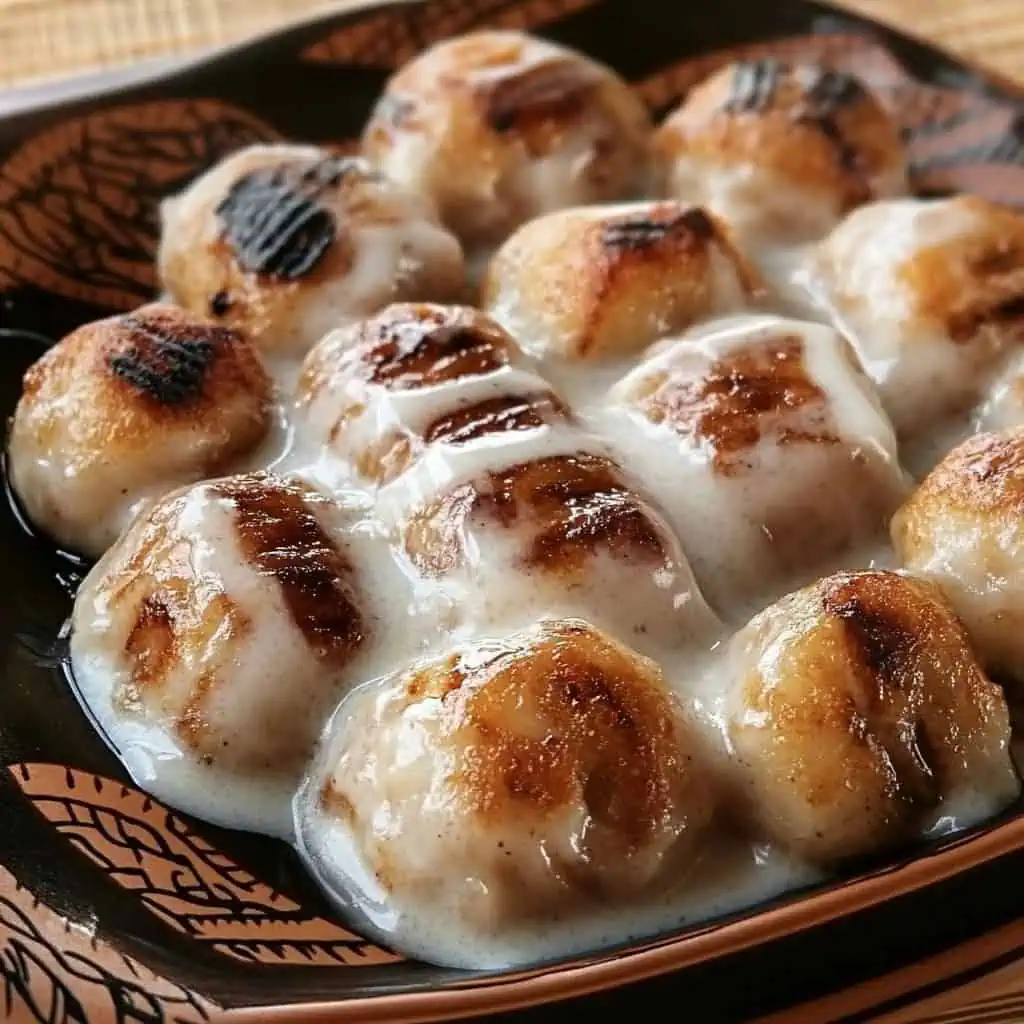
Why You'll Love This Recipe
- Perfect Balance: Experience the harmonious combination of chewy rice balls, sweet bean filling, and creamy coconut sauce
- Cultural Heritage: Make an authentic Filipino kakanin that's been perfected through generations
- Customizable: Easy to adjust sweetness and texture to your preference
- Special Occasion Worthy: Impressive dessert that's perfect for gatherings and celebrations
- Healthier Version: Our adaptation includes chia seeds for added nutrition
Ingredients
The ingredients in this Bibingkoy recipe have been carefully selected to create an authentic Cavite experience in your kitchen. Glutinous rice flour provides the signature chewy texture that Filipinos love in their kakanin. Red bean paste offers a natural sweetness that complements the rice without overwhelming it.
Fresh banana leaves aren't just for cooking, they infuse the Bibingkoy with an irreplaceable aroma that signals a special treat. The coconut milk sauce creates a creamy contrast to the chewy rice balls, while ripe jackfruit adds bursts of tropical sweetness. Chia seeds are our modern addition, providing both nutrition and a pleasing texture similar to traditional bilo-bilo.
Together, these ingredients create a perfect balance of textures and flavors that honors this beloved Filipino delicacy while making it accessible for home cooks.
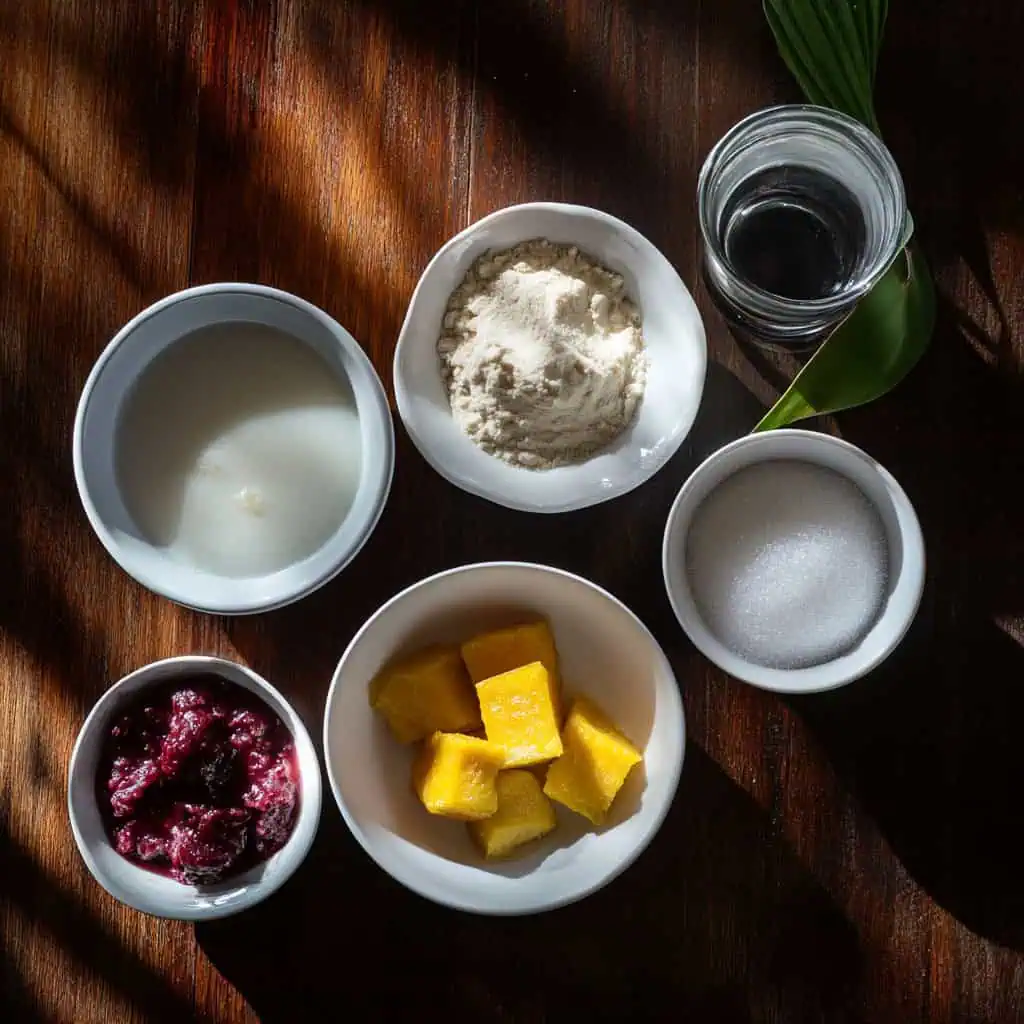
For the Ginataang Sauce:
- 2 Cans (13.5oz each) Coconut Milk
- ¼ Cup Chia Seeds
- 1 Cup Super Ripe Jackfruit, diced
- Palm Sugar to taste (optional)
For the Rice Balls (Bilo Bilo):
- 2 Cups Sweet Glutinous Rice Flour
- 1 Cup Water
- ½ Cup Sugar
- ½ Cup Smooth Red Bean Paste
Equipment
- Outdoor Grill (Ihawan) - For achieving the traditional smoky flavor that makes Bibingkoy authentic
- Grill Basket - Holds the rice balls securely while grilling and prevents them from falling through the grates
- Clean Banana Leaves - For wrapping and imparting traditional aroma to the rice cakes
- Saucepan - For preparing the coconut sauce to the perfect consistency
- Ice Cream Scoop - Creates uniformly sized balls for even cooking and presentation
- Mixing Bowls - For preparing the dough and other components separately
- Measuring Cups and Spoons - For accurate measurements to ensure recipe success
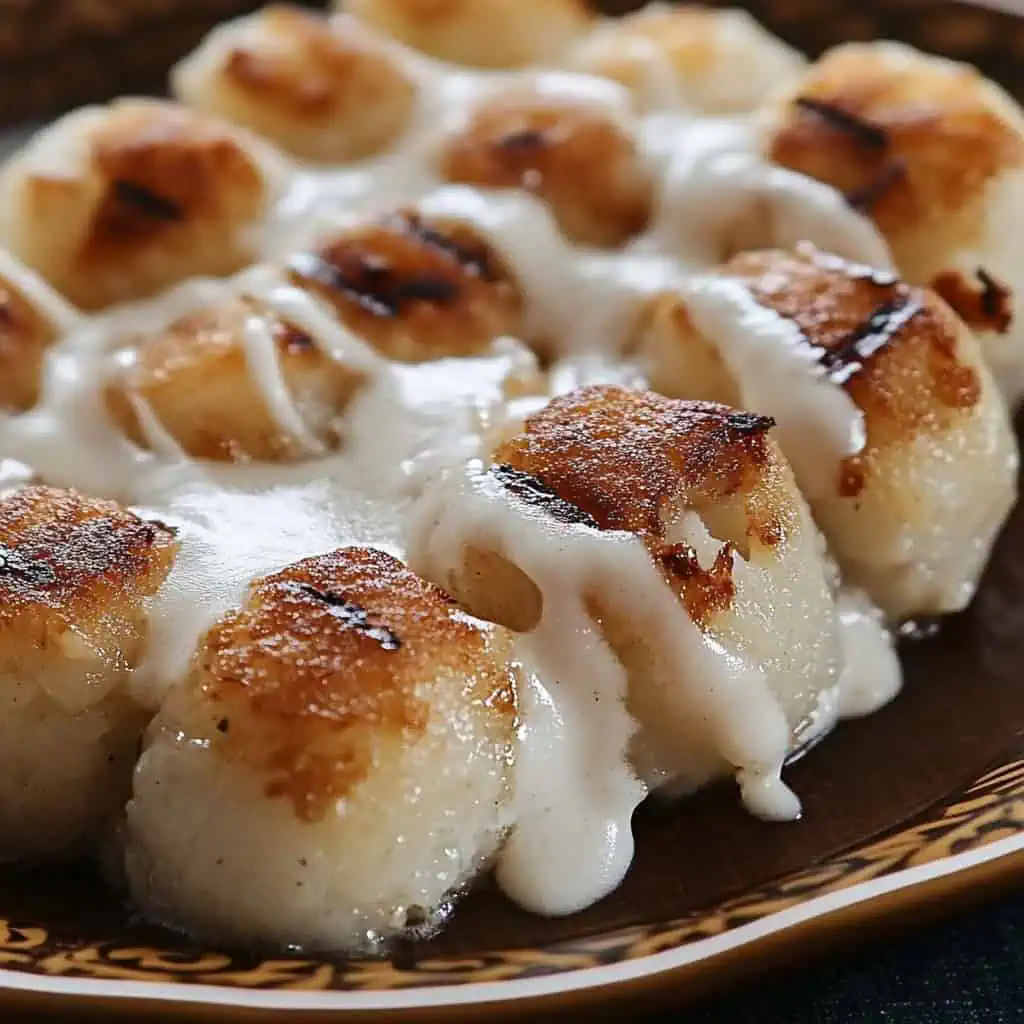
How To Make
- Begin by making the coconut sauce. Pour 2 cans of coconut milk into a saucepan over medium heat. Add ¼ cup chia seeds and bring to a gentle boil. Lower the heat and simmer for 5 minutes. Remove from heat, stir in 1 cup of diced ripe jackfruit, then transfer to a serving bowl and set aside.
- For the rice balls, combine 2 cups of glutinous rice flour and ½ cup sugar in a large mixing bowl. Add 1 cup of water gradually while mixing with your hands until you form a soft, smooth dough. Using an ice cream scoop, portion the dough into equal-sized balls. Then measure out matching portions of red bean paste using a teaspoon.
- Take each dough ball and flatten it into a disc. Make a small indentation in the center with your thumb. Place a portion of red bean paste in the center. Carefully pinch and seal the edges of the dough around the filling, then roll into a smooth ball. Repeat with remaining dough and filling.
- Preheat your outdoor grill to medium heat (175°C/350°F). Line a grill basket with clean banana leaves. Arrange the filled balls close to each other on the leaves. Cover with another layer of banana leaves, tucking in the edges. Close the grill basket securely.
- Place the basket on the grill and cook for 15 minutes. Flip the basket and continue cooking for another 10-15 minutes until the Bibingkoy is soft and slightly toasted. You can check doneness by carefully lifting the banana leaves - the balls should be very soft to touch.
- To serve, cut the desired number of balls into smaller pieces while still warm. Place in serving bowls and top generously with the warm coconut-jackfruit sauce. Serve immediately.

Tips from Lola's Kitchen
- Keep your hands slightly damp while working with the dough to prevent sticking
- For authentic aroma, air out your banana leaves briefly before using (pahanginan muna)
- The glutinous rice dough should feel like soft play dough - not too sticky and not crumbly
- Don't rush the cooking process - the slow grilling develops the characteristic flavors
- Look for a yellowish-brown color on the banana leaves as a sign of perfect doneness
- Allow the Bibingkoy to rest for 2-3 minutes after grilling before cutting for the best texture
Substitutions
- Red Bean Paste: Use ube halaya (purple yam jam) or sweetened mung beans (munggo)
- Jackfruit: Substitute with ripe mango chunks or diced sweet potato for different flavors
- Chia Seeds: Replace with small tapioca pearls (sago) or nata de coco for traditional texture
- Banana Leaves: In a pinch, use parchment paper or aluminum foil, though you'll miss some aroma
- Glutinous Rice Flour: In emergencies, mix regular rice flour with tapioca starch (3:1 ratio)
Troubleshooting
- Dough too sticky? Add more glutinous rice flour, one tablespoon at a time
- Dough too dry or cracking? Add water one teaspoon at a time until it reaches the right consistency
- Filling leaking out during cooking? Make sure to seal the edges completely and avoid overfilling
- Sauce too thin? Simmer longer or add additional chia seeds
- Sauce too thick? Add more warm coconut milk, a little at a time
- Bibingkoy not cooking through? Your grill temperature might be too high - lower it and cook longer
Storage & Reheating
- Bibingkoy is best consumed fresh, right after cooking
- If needed, store at room temperature covered with banana leaves for up to 24 hours
- For longer storage, refrigerate in an airtight container for up to 3 days
- Reheat in microwave for 1 minute or steam for 3-5 minutes until warmed through
- Store sauce separately in the refrigerator for up to 3 days
- When reheating sauce, warm gently on low heat, adding a splash of coconut milk if needed
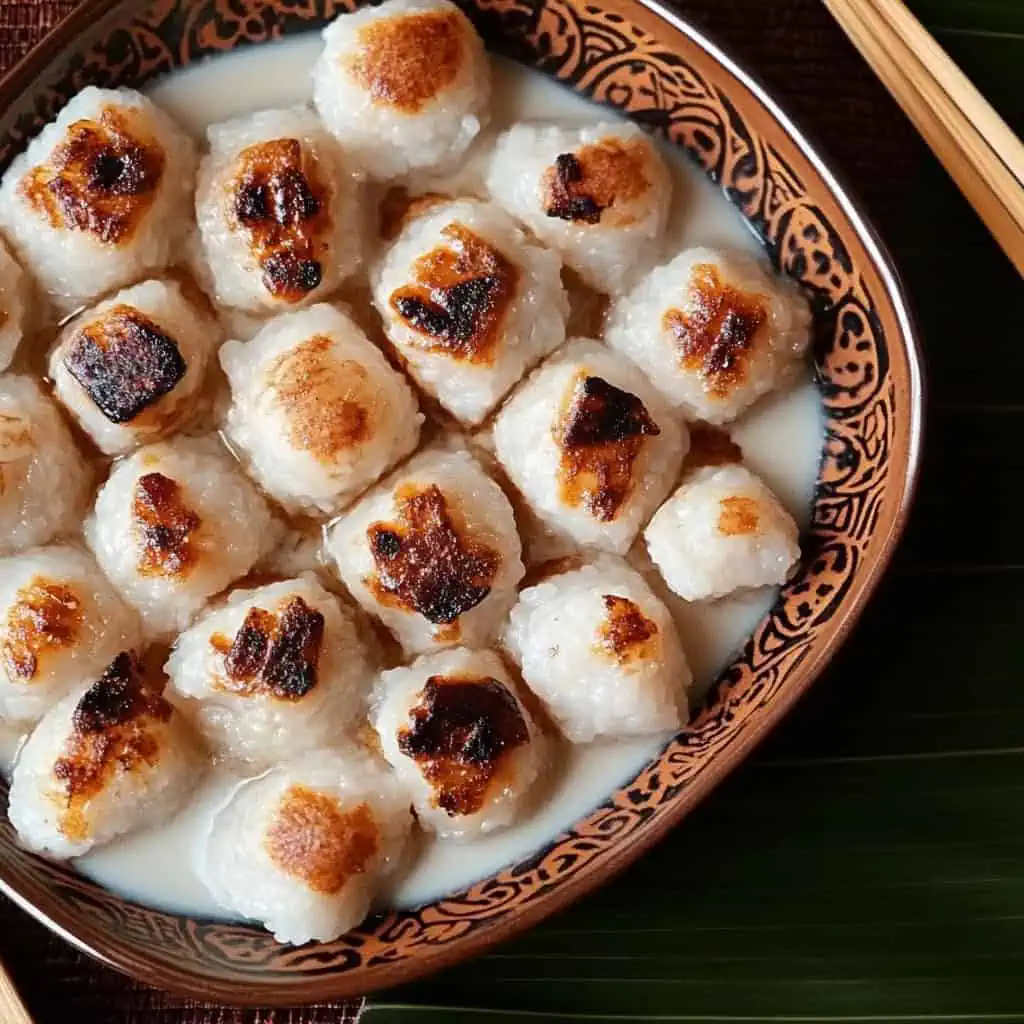
FAQ
Can I make this without a grill?
Yes! You can use an oven set to 180°C/350°F with a water bath placed on the bottom rack for humidity. Wrap the bibingkoy in banana leaves, then in foil, and bake for about 25-30 minutes.
How do I know when the Bibingkoy is fully cooked?
The balls should be soft and slightly bouncy when pressed gently. If you cut one open, the dough should be translucent rather than opaque.
Can I make this ahead of time for a party?
While best served fresh, you can prepare the components separately ahead of time. Make the sauce and filling a day before, then prepare and cook the rice balls shortly before serving.
Why add chia seeds to the sauce?
Chia seeds add nutrition and help thicken the sauce naturally while providing texture similar to traditional bilo-bilo. They're also rich in omega-3 fatty acids and fiber.
Is this gluten-free?
Yes, when made with certified gluten-free glutinous rice flour. Despite its name, glutinous rice flour doesn't contain gluten - it's named for its sticky quality.
How do I prevent my Bibingkoy from becoming too dense?
Don't overwork the dough when mixing, and make sure not to cook them too long, which can make them tough rather than tender.
Can I freeze uncooked Bibingkoy?
Yes! Arrange the shaped, filled balls on a baking sheet, freeze until solid, then transfer to a freezer bag. Cook from frozen, adding 5-7 minutes to the cooking time.
Related
Looking for other recipes like this? Try these:
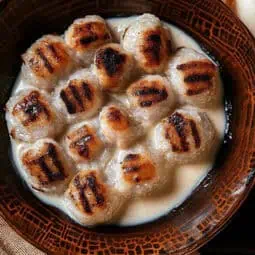
Authentic Cavite Bibingkoy Recipe
Equipment
- Outdoor Grill (Ihawan) For achieving the traditional smoky flavor
- Grill Basket (Basket na Pangihaw) Holds the rice balls securely while grilling
- Clean Banana Leaves (Dahon ng Saging) For wrapping and imparting traditional aroma
- Saucepan (kaserola) For preparing the coconut sauce
- Ice Cream Scoop For uniformly sized balls
- Mixing bowls (mangkok) For preparing the dough
- Measuring cups and spoons (Panukat) For accurate measurements
Ingredients
For the Ginataang Sauce
- 2 Cans 13.5oz each Coconut Milk Gata ng Niyog
- ¼ Cup Chia Seeds
- 1 Cup Super Ripe Jackfruit Hinog na Langka, diced
- Optional: Palm Sugar Panutsa to taste
For the Rice Balls (Bilo Bilo)
- 2 Cups Sweet Glutinous Rice Flour Galapong
- 1 Cup Water Tubig
- ½ Cup Sugar Asukal
- ½ Cup Smooth Red Bean Paste
Instructions
- Begin by making the coconut sauce. Pour 2 cans of coconut milk into a saucepan over medium heat. Add ¼ cup chia seeds and bring to a gentle boil. Lower the heat and simmer for 5 minutes. Remove from heat, stir in 1 cup of diced ripe jackfruit, then transfer to a serving bowl and set aside.
- For the rice balls, combine 2 cups of glutinous rice flour and ½ cup sugar in a large mixing bowl. Add 1 cup of water gradually while mixing with your hands until you form a soft, smooth dough. Using an ice cream scoop, portion the dough into equal-sized balls. Then measure out matching portions of red bean paste using a teaspoon.
- Take each dough ball and flatten it into a disc. Make a small indentation in the center with your thumb. Place a portion of red bean paste in the center. Carefully pinch and seal the edges of the dough around the filling, then roll into a smooth ball. Repeat with remaining dough and filling.
- Preheat your outdoor grill to medium heat (175°C/350°F). Line a grill basket with clean banana leaves. Arrange the filled balls close to each other on the leaves. Cover with another layer of banana leaves, tucking in the edges. Close the grill basket securely.
- Place the basket on the grill and cook for 15 minutes. Flip the basket and continue cooking for another 10-15 minutes until the Bibingkoy is soft and slightly toasted. You can check doneness by carefully lifting the banana leaves - the balls should be very soft to touch.
- To serve, cut the desired number of balls into smaller pieces while still warm. Place in serving bowls and top generously with the warm coconut-jackfruit sauce. Serve immediately.
- Notes for success: Keep your hands slightly damp while working with the dough to prevent sticking. If your sauce becomes too thick, thin it with additional warm coconut milk. The banana leaves should show a slight yellowish-brown color when the Bibingkoy is properly cooked.
Tips from Lola's Kitchen
- Use fresh banana leaves for authentic aroma (pahanginan muna ang dahon)
- Keep hands slightly wet when forming balls to prevent sticking
- Don't overcrowd the grill basket for even cooking
- Look for yellowish-brown color on the banana leaves as a sign of doneness
Nutrition
The Story Behind Cavite's Bibingkoy
In the heart of Cavite, a province known for its rich culinary heritage, there's a special kakanin (rice cake) that locals speak of with pride and nostalgia - the Bibingkoy. While many Filipino desserts feature glutinous rice and coconut milk, this grilled delicacy stands out for its unique preparation and the story behind it.
The tale of Bibingkoy is inseparable from Aling Ika's Carinderia in Cavite, where Lolit Alejo transformed this humble rice cake into a local legend. What started as a simple merienda (afternoon snack) became one of Cavite's most sought-after delicacies, drawing food lovers from across the Philippines to taste this special creation.
Think of Bibingkoy as the sophisticated cousin of palitaw, another beloved Filipino rice cake. But instead of just flat rice cakes, Bibingkoy takes things up a notch by stuffing sweet bean paste inside chewy rice balls, then grilling them between banana leaves until perfectly cooked. The final touch? A warm, creamy coconut sauce studded with ripe jackfruit that turns each bite into a celebration of flavors.
Traditional Bibingkoy preparation is a labor of love, requiring both skill and patience. In the old days, cooks would grill the rice cakes between layers of hot coals, carefully monitoring the heat to achieve that perfect texture. This method gave Bibingkoy its distinct slightly smoky aroma that perfectly complements the sweetness of the filling and sauce.
Today, while modern kitchens might not have the traditional coal-fired setup, home cooks have adapted the recipe to keep this treasured delicacy alive. Whether it's served at family gatherings, fiestas, or as a special merienda treat, Bibingkoy continues to tell the story of Cavite's rich food culture and the creativity of Filipino cooks who turn simple ingredients into extraordinary dishes.
What makes Bibingkoy truly special isn't just its unique preparation or delicious taste - it's how it brings people together. Like many beloved Filipino foods, it's a dish that's meant to be shared, enjoyed leisurely over afternoon conversations, creating memories that last a lifetime. Every bite of Bibingkoy carries with it the warmth of Filipino hospitality and the pride of Caviteño culinary tradition.
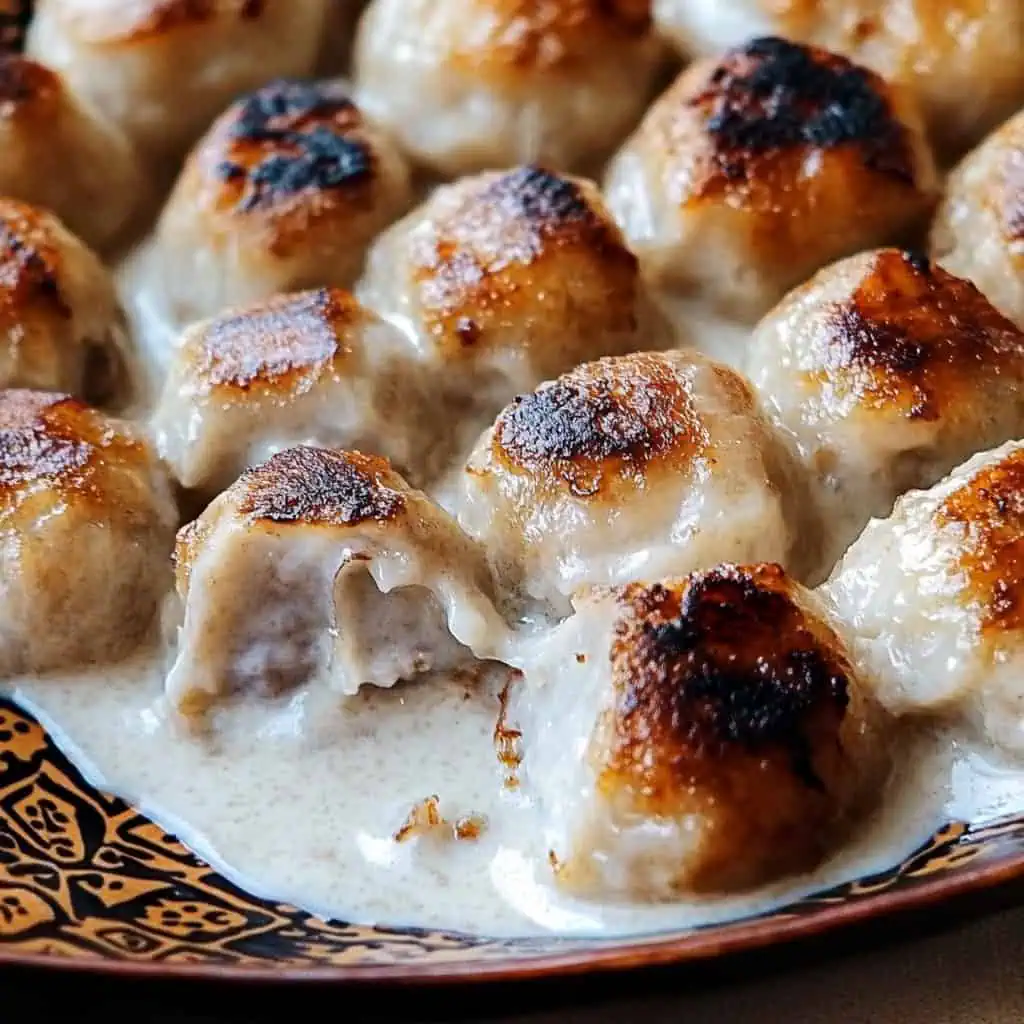

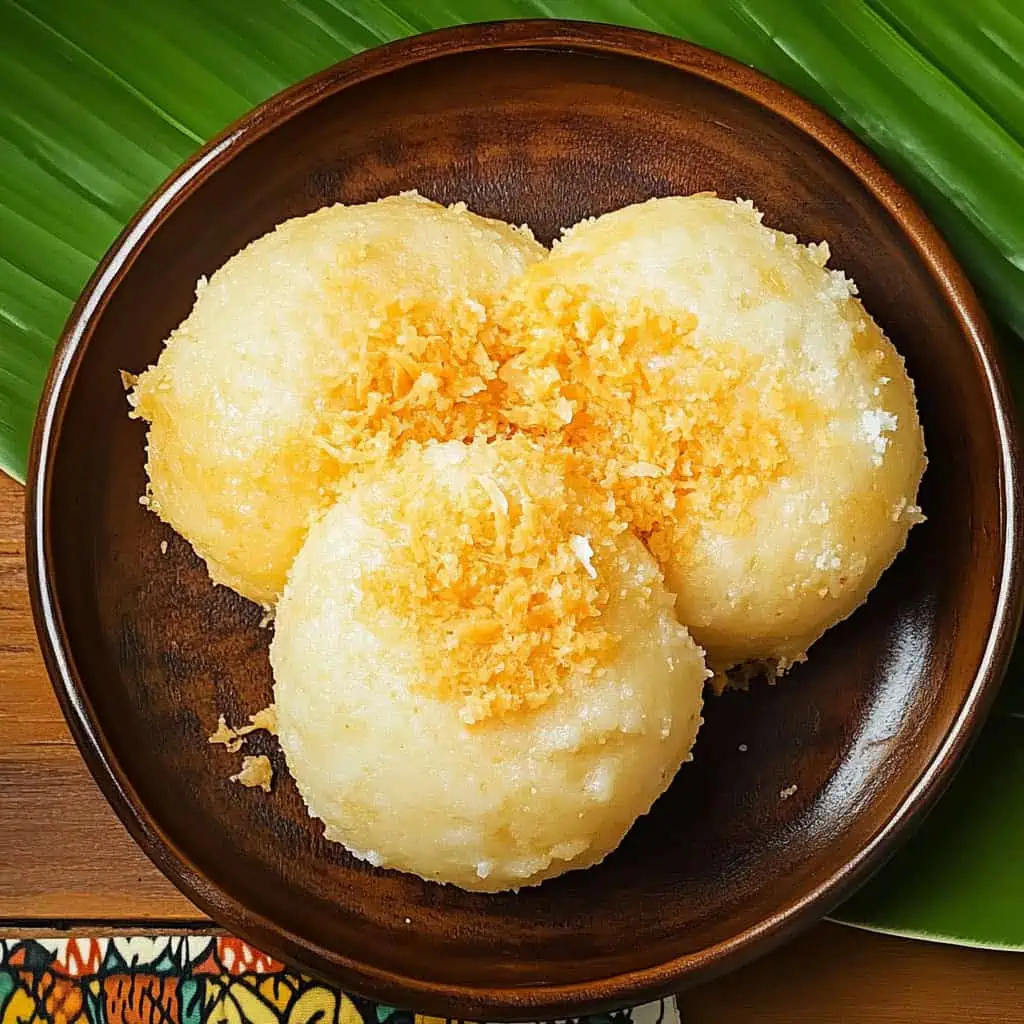
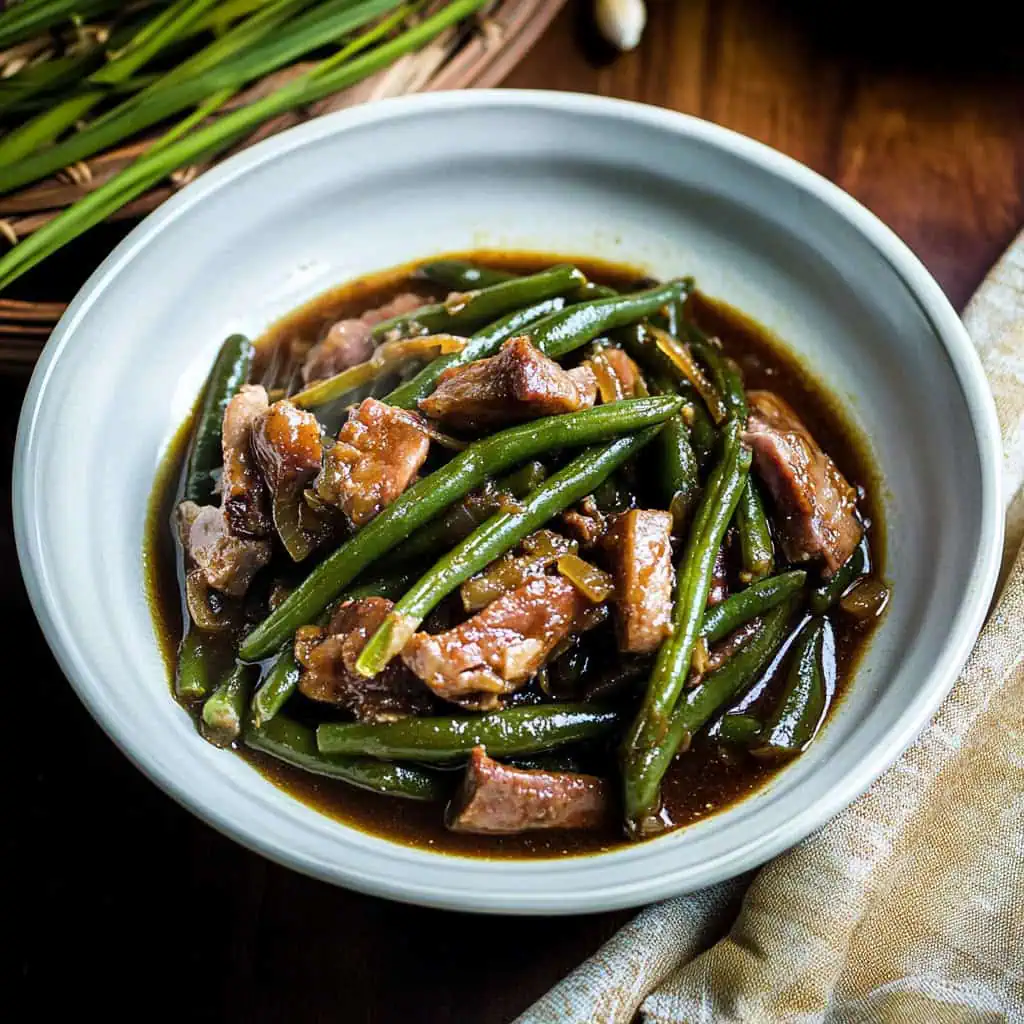

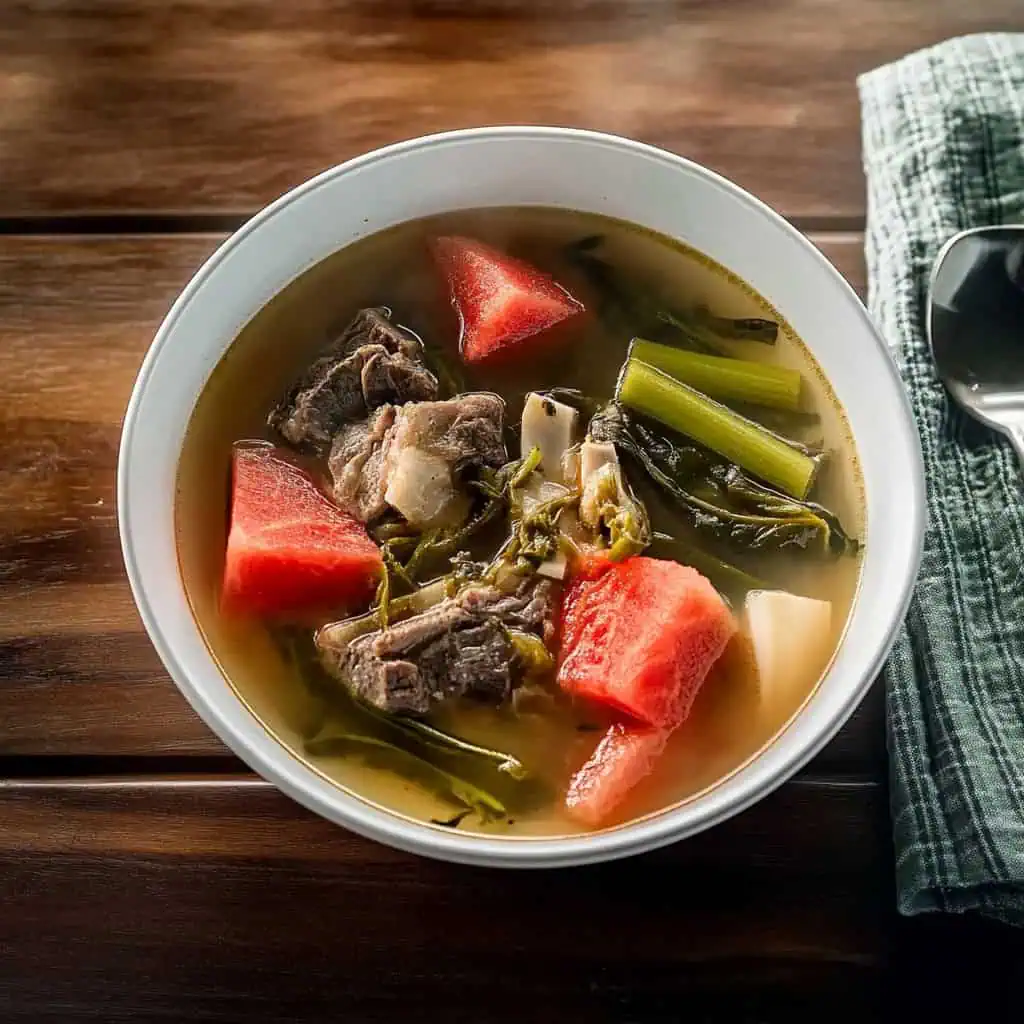


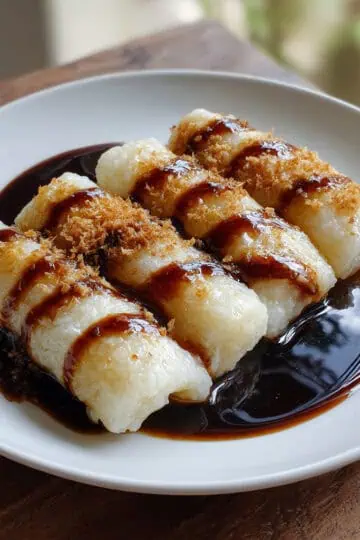
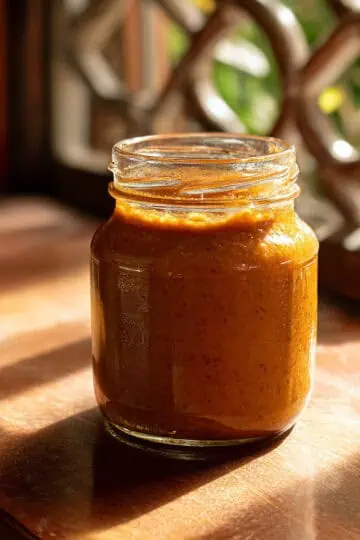
Comments
No Comments